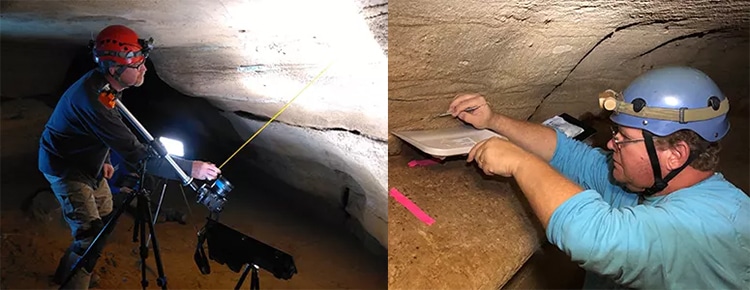
An artist’s representation of prehistoric undewater life, 325 million years ago. (Photo: Julius Csotonyi/NPS image)
The Mammoth Cave National Park is not just a collection of incredible stalactites and underground pathways. It is proving to be a window into prehistoric marine life. The ancient waters, which carved the caves, exposed fossils embedded in ancient rock. During work for a paleontological survey, which commenced in 2019, researchers discovered a collection of incredible prehistoric shark fauna sticking out of the cave walls. The collection of ancient sea life includes several shark species previously unknown to researchers, such as the 337-million-year-old Strigilodus tollesonae.
According to a National Park Service (NPS) statement, “Several of the caves in the park were known to contain the fossil remains of ice age mammals in unconsolidated deposits and fossils of ancient marine organisms preserved within the limestones in which the caves developed.” The caves traverse limestone deposits which formed 325 million years ago during the late Paleozoic era, more specifically the Mississippian Period. This period ran from about 358.9 million years ago to 323.2 million years ago, and it has left us with countless fossils. According to the NPS, “During the Mississippian Period, shallow seas covered much of North America.” That’s why the fossils of the caves have been those of aquatic creatures.
Over 40 ancient shark and related species have been uncovered in the caves during the past year of study. JP Hodnett, a paleontologist and fossil shark expert, was called in to facilitate the research. He noted in a statement, “I am absolutely amazed at the diversity of sharks we see while exploring the passages that make up Mammoth Cave. We can hardly move more than a couple of feet as another tooth or spine is spotted in the cave ceiling or wall. We are seeing a range of different species of chondrichthyans [cartilaginous fish] that fill a variety of ecological niches, from large predators to tiny little sharks that lived amongst the crinoid [sea lily] forest on the seafloor that was their habitat.”
Among these interesting species was the previously unknown Strigilodus tollesonae. Its petal-shaped teeth gave it its name, which translates to mean “Tolleson’s Scraper Tooth.” The name also honors park guide Kelli Tolleson for her “outstanding field support” during the research. The shark species is still quite newly catalogued, but it shows distinct dental and fin characteristics. Since most of the fossils are in parts of the cave unaccessible to the public, the NPS has announced two photogrammetic 3D images of shark fossils. Viewers can explore the Glikmanius and top-predator of the ecosystem, Saivodus striatus. For those who find a fossil hard to visualize, the NPS has provided an image (above) that gives an artist’s insight into how the shallow ancient seas may have teemed with life, long before the caves which now stand on that spot.
In Mammoth Cave National Park, the prehistoric shark species known as Strigilodus tollesonae dazzled researchers with its unique teeth and fins.

JP Hodnett, paleontologist, on the right. Jack Wood, geologist, on the left.(Photo: NPS Photo)
h/t: [Interesting Engineering]
Related Articles:
9-Year-Old Paleontology Lover Finds Giant Megalodon Tooth on Maryland Beach
66-Million-Year-Old Fully Articulated Dinosaur Embryo is Discovered Inside of a Fossilized Egg
Great White Shark’s GPS Tracking Path Unexpectedly Creates a Self-Portrait
Whale Shark With Over 50 Fish in Its Mouth Wins Underwater Photo Contest
